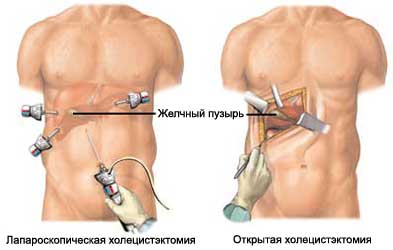Cholecystectomy – Removal of the gallbladder – laparoscopic surgery
Description gallbladder removal
Cholecystectomy – surgical removal of the gallbladder. This organ is located near the liver, and stores bile, which is produced in the liver. Bile helps digest fatty foods. Bile from the gall bladder out through the ducts to the small intestine.
Cholecystectomy is most often performed laparoscopically, In some cases, the physician can switch to open surgery to remove gall bladder. This method includes the incision in the abdominal cavity.

What held removal of the gallbladder?
This operation is used, to remove diseased or damaged gall bladder. Damage is usually applied to infection or inflammation. Damage often occurs because of gallstones, which are crystals of bile, and can form in the gall bladder. Sometimes they get stuck in the ducts, through which bile flows. This blockage in the ducts can damage the gallbladder and liver.
Possible complications of gallbladder removal
Complications are rare, but no procedure does not guarantee the absence of risk. Before, how to perform the removal of the gallbladder, you need to know about possible complications, which may include:
- Gallstones, who accidentally fell into the abdominal cavity;
- Bleeding;
- Infection;
- Damage to other nearby structures or organs;
- Reactions to general anesthesia;
- Blood clots.
Some factors, that may increase the risk of complications:
- Age: 60 and older;
- Pregnancy;
- Obesity;
- Smoking;
- Malnutrition;
- Recent or chronic illness;
- Diabetes;
- The problems of the heart or lungs;
- Blood clotting;
- Alcohol and drug use;
- The use of some drugs.
How is the removal of the gallbladder?
Preparation for the procedure
Before the procedure the doctor, probably, appoint the following tests:
- Blood tests to assess liver function;
- Ultrasonography to detect gallstones;
- Gallbladder scintigraphy (hepatobiliary iminodiacetic acid scan) – X-ray test, in which a chemical substance is introduced into the gallbladder, allowing you to take pictures of the liver, gallbladder, ducts and small intestine;
- and electrocardiogram chest X-ray, To make sure, that the heart and lungs are healthy enough, to withstand during surgery.
Before the procedure:
- The patient may be asked to stop taking certain medicines a week before the procedure,:
- Aspirin or other anti-inflammatory drugs;
- Blood-thinning drugs, such as clopidogrel or warfarin;
- We need to organize a trip to the hospital and back after surgery, as well as help at home after the procedure;
- In the evening before surgery you can eat a light meal. You can not eat or drink anything after midnight on the day of the procedure;
- The patient may be given:
- Laxatives and / or an enema;
- Antibiotics;
- If it is indicated, you need to take a shower before the procedure.
Anesthesia
Used general anesthesia. The patient will sleep during the procedure.
Procedure gallbladder removal
The abdomen will be made four small holes. Further, in the stomach will download carbon dioxide, which will provide a better view inside the abdomen.
The laparoscope is inserted through one of the holes. It conveys an image of the gallbladder and bodies around him on the monitor. Other tools will be inserted through the remaining three holes. They will be used for the separation of the gallbladder and its cut-off from the surrounding organs and duct. The gallbladder is removed through one of the holes.
A doctor may enter the dye into the bile ducts. This may indicate, Do they have gallstones. The entire abdomen will be carefully examined. The incisions will be closed sutures or staples, they bandage.
The doctor may place a small, flexible tube in the region, where the gallbladder was removed. These drainage tubes used to drain any fluids, that can accumulate during the first few days after surgery. The tubes are typically removed within one week after surgery.
Immediately after removal of the gallbladder
The patient was sent to the House for the recovery and monitoring of vital parameters.
How long will the removal of the gallbladder?
About 30-60 minutes.
Laparoscopic removal of the gallbladder – Will it hurt?
Probably, the patient feels pain after surgery. In this case, the doctor will prescribe pain medication.
The average hospital stay
If the patient has no problems, he will be able to go home the day of surgery or the next day.
Caring for a patient after removal of the gallbladder
Care in a hospital
- The patient is monitored for detecting any problems encountered;
- You may need medicine for nausea;
- Feeding the patient is performed by introducing nutrients intravenously;
- Once the patient is able to eat by mouth, He transferred to the liquid diet, which gradually becomes normal.
Home Care
Recovery takes about three weeks.
Upon returning home, you need to perform the following actions, to ensure the normal recovery:
- We need to ask your doctor about, when it is safe to shower, bathe, or to expose the surgical site to water;
- It will be a plan of diet and physical activity, to aid in recovery;
- Be sure to follow your doctor's instructions.
Contact your doctor after removal of the gallbladder
After discharge from the hospital need to see a doctor, If the following symptoms:
- Signs of infection, including fever and chills;
- Redness, edema, increased pain, bleeding, or any discharge from the incision;
- Cough, breathlessness, chest pain;
- Increased abdominal pain;
- Pain, which does not pass after taking pain medication appointed;
- Blood in the stool;
- Nausea and / or vomiting, which do not disappear after taking the prescribed medicines, and persist for more than two days after discharge from the hospital;
- Bloating and gas – If symptoms persist for more than one month;
- Pain, burning, frequent urination, blood in urine;
- Pain and / or swelling of the legs, calves and feet;
- Dark urine, bright chair, or signs of jaundice (yellowing of the skin or eyes).
